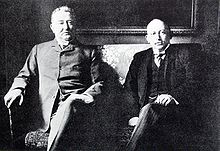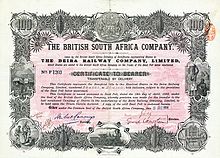British South Africa Company
The British South Africa Company (BSAC or BSACO) was a British business enterprise that developed and administered areas of "Zambezia" - today Zimbabwe and Zambia. It was founded by Cecil Rhodes and Alfred Beit.
In 1888, the Englishman Charles Rudd, on behalf of the South African Goldfield Company, had acquired from the Matabele ruler Lobengula the exclusive rights to metals and minerals in his kingdom. A short time later, Edward Arthur Maund appeared on behalf of the Exploration Company with equal and still further claims.
Rhodes, a member of parliament at the Cape and founder of the De Beers Diamond Mining Company in Kimberley, finally managed to reconcile the individual interests and set up the British South Africa Company with Alfred Beit. Beit looked after the finances of the venture. He and Rhodes took over shares worth £120,000 sterling, De Beers took over £200,000, Gold Fields took over nearly £100,000 and the Exploration Company took over £75,000. The company sold mining rights, mainly in Rhodesia, on condition of a 50 per cent interest in the ore discoveries. The company received a letter of protection (Royal Charter) from the British government on October 15, 1889, granting it almost complete autonomy in the administration of Matabele, Maschona and Manikaland. Only foreign relations were reserved for Great Britain. From 1899 the BSAC also exercised control over Barotseland, later called North West Rhodesia, and from 1900 also over North East Rhodesia.
An expedition under Colonel Pennefather occupied Southern Rhodesia in September 1890. Advancing later against Manika, there was a bloody conflict with the Portuguese at Massi Kessi in May 1891. As a result, on 11 June 1891, the British government forced a treaty by which Manika and its goldfields became the property of the BSAC.
The Matabele under Lobengula were defeated in 1893 and brought under the immediate rule of the British South Africa Company in 1896. The new colony soon saw an influx of settlers and gold miners. In 1897 there were about 7,000 whites, and in 1899 there were 4,000 inhabitants in the capital, Bulawayo, alone. The new colony, far from the sea, was immediately opened up by two railway lines. The first, from Mafeking, the administrative seat of British Bechuanaland, to Bulawayo, was built from 1896 to November 1897. The second, between Beira in then Portuguese Mozambique and Salisbury, now Harare, was opened to traffic on 1 May 1899.
The British South Africa Company, as demonstrated in the Jameson Raid, was an instrument of British colonial policy that provided opportunities for London not to be a direct actor. From January 1898, the BSAC was under 'very tightened' control by the British colonial authorities. This duplicity of British violent policy in Africa south of the Zambezi was explicitly disapproved of internationally. Moreover, the BSAC had been obliged at its foundation to make the British Empire its heir.

The Rhodes Colossus : Caricature of Cecil Rhodes and Africa from Cairo to Cape Town

Cecil Rhodes and Alfred Beit 1896

Share of the British South Africa Company dated 13 December 1894
Search within the encyclopedia